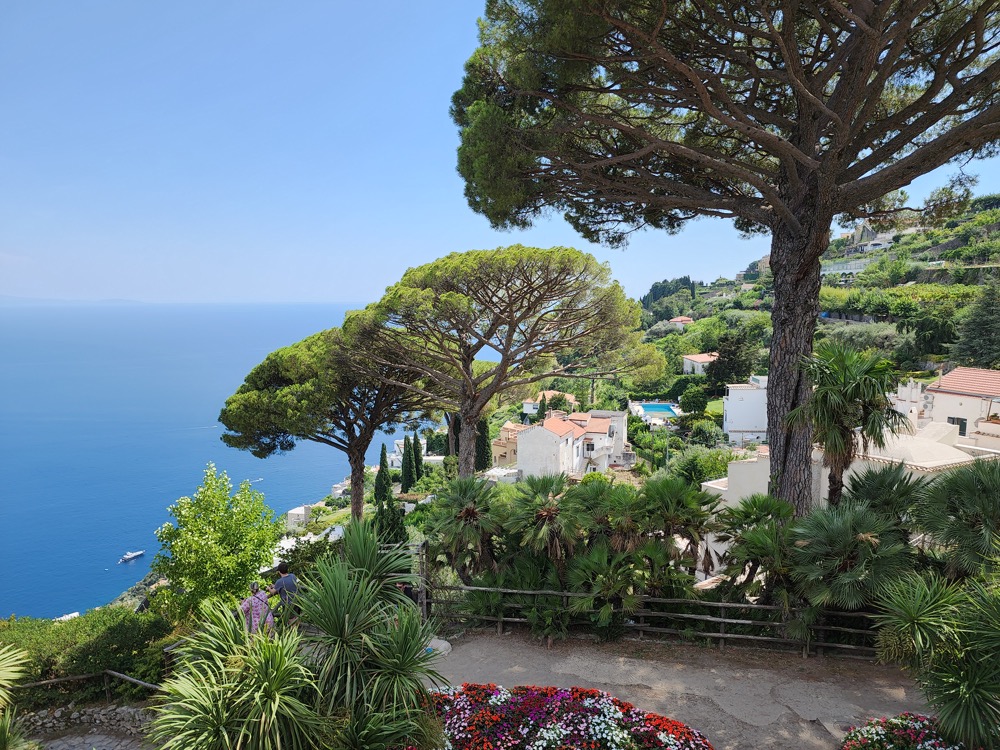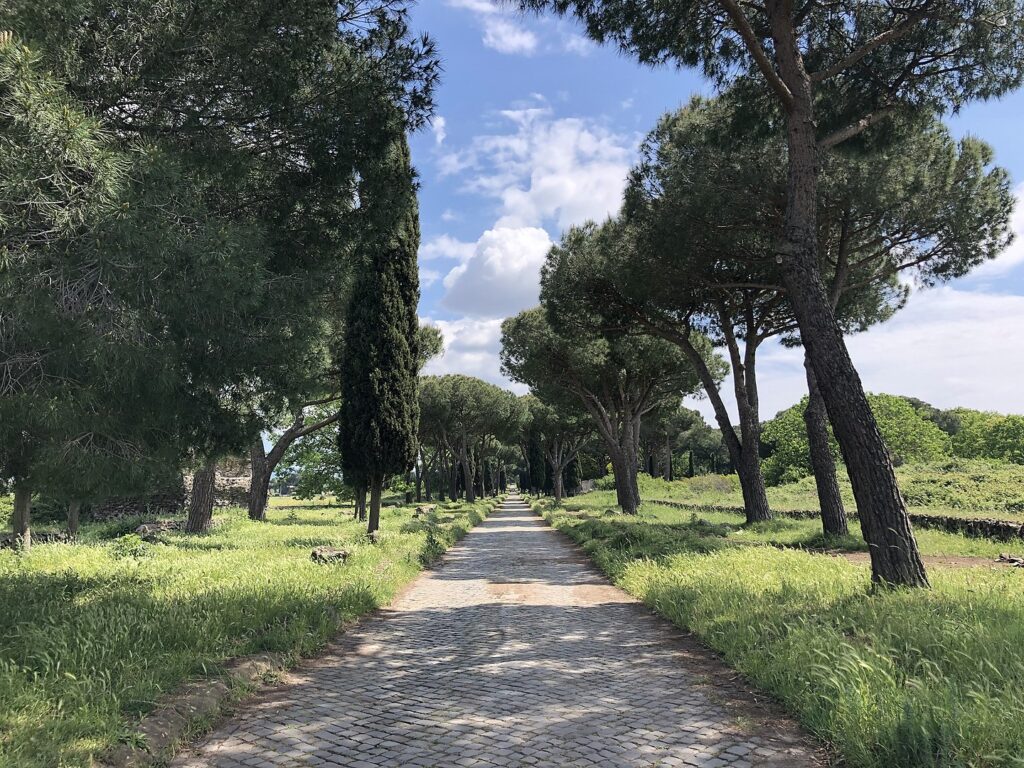
An Ode to the Stone Pine
It is that which is between the palaces, that gives Italy its true beauty. If you took away every change that human hands have wrought on Italy’s landscape, it would a still be paradise. One tree, the Stone Pine, gives a distinct beauty the Italian landscape, yet we rarely hear it mentioned.
Did human hands shape it to tower above and spread like a protective canopy? Or was it the ancient gods of Italy’s streams and mountains, who created it in its gracious form?
Although I have seen it many times (and it impresses itself on any traveller arriving in Italy) only recently did I seek out its story. You find it in Italy’s cityscape and gardens. You find it rising above vineyard and olive groves in remote rural settings. Its spreading fronds still shelter the traveller along the Appian Way.
It is a symbol of Rome, yet its story is far more ancient. So ancient, that scientists cannot tell us its place of origin, though we find it all about the Mediterranean shore. For centuries it gave not only shelter but also food. Human beings have harvested its pine nuts from time out of mind. Near 50,000 years ago, human beings, and perhaps as long ago as 150,000 years ago Neanderthal humans, were using the pine nut of the Stone Pine.
Most of the oldest archeological finds for the Stone Pine are found in Spain or Portugal. Nonetheless the Pine was being used by the ancient Romans from as early as the Republic Period. The Greek Theothrastus (third century BC) spoke of it before Roman domination. To the ancients, it was prized for the aphrodisiac properties of its nuts, and the uses of its sap in medicine. Its uses extend however beyond this, being used in naval construction and other products.

In its youth, the Stone Pine appears like a shrub, which in middle age takes on an umbrella shape, and in full maturity a flat spreading out above the red brown bark of its trunk, which can rise to 25 metres.
It is not the pine of choice in the city in Australia where I live where the Radiata Pine was the import of choice, for the Stone Pine does not grow fast enough to commend it for the building a new city. Nevertheless, Canberra has examples in two places. A single stately tree rises over the entry to the Governor General’s residence, clearly planted long ago. A stand of still juvenile Stone Pines grows in the city’s arboretum: the fifty-sixth of its hundred forests. Yet no sea breeze blows in my city and they are far from the Mediterranean from whence they came. The feature image above illustrates some particularly beautiful examples of the Stone Pine in the setting of the Villa Rufolo, Ravello, on the Amalfi coast.
Mary and Elizabeth Kirby in their 1873 Chapters on Trees, celebrated the Stone Pine (also known as the “Italian Pine”, and noted its association with the Italian landscape.
There is one of the numerous family of Pines which is always associated with the brilliant sky and classic landscape of Italy. It suggests ideas of the broken columns and shattered temples of cities once great and beautiful, but now passed away. The artists have frequently placed it in their pictures, by such venerated ruins; nay, there is scarce a sketch of Italian scenery where it is not found. It is the Pine of the painter and of the poet.
M & E Kirby, Chapter on Trees A Popular Account of their Nature and Uses, Cassel, Petter & Galpin, p 157
In the 1885 periodical, the Garden, we find the same association in the mind of writers of the era.
… the Stone Pine possesses a peculiar interest beyond that of any other European conifer. From the earliest periods it has been the theme of classical writers. Ovid and Pliny describe it; Virgil alludes to it as the most beautiful ornament; and Horace mentions a pine agreeing in character with the Stone Pine. …
The Garden Illustrated Weekly Journal, Volume XXVII, London 1885, p 245

The Stone Pine is usually found alone or in small stands. The city of Ravenna (which hosts magnificent Byzantine era edifices) also boasts a particularly famous forest in its vicinity. Dante mentions the forest in his epic poem La Divina Commedia. Boccaccio, too, places one of his stories from the Decameron in the forest. Botticelli painted scenes from the story graced by towering Stone Pines (although the story itself has little to commend it).
Lord Byron (in his many travels) visited the forest which entered his poetry (Don Juan, Canto 3, 105).
Sweet hour of twilight! in the solitude Of the pine forest, and the silent shore Which bounds Ravenna’s immemorial wood, Rooted where once the Adrian wave flowed o’er To where the last Cæsarean fortress stood, Evergreen forest; which Boccaccio’s lore And Dryden’s lay made haunted ground to me, How have I loved the twilight hour and thee!
The ‘last Caesarian fortress‘ of course alludes to the fall of the western Roman Empire. Ravenna was its last capital. Continuing the Roman theme, the pine nut (sourced from Stone Pines) made a frequent appearance in the cookbook of Caelius Apicius. It appeared in recipes for various desert puddings, sauces for meats, or a garnish for poached eggs.
Despite the association with Italy discussed above, the Iberian peninsula has the largest populations of Stone Pines. Portugal, in particular, boasts the world’s largest Stone Pine woods. People around the world today include pine nuts in their diet and it appears in the traditional recipes of many cuisines. Among them, is a pilaf known as Lebanese Hushweh (but there are many others). The Mediterranean of course includes its North African and Middle Eastern shore. We find the Stone Pine there too.
The Stone Pine has even inspired its own poetic symphony titled the “Pines of Rome”. Written by Ottorino Respighi, it celebrates stands of the Stone Pine in Rome. Places such as the Villa Borghese (1st movements) and the Via Appia (4th Movement) appear in its melodies. Orchestras around the world today perform the composition.
Additional Sources for the Stone Pine
Forest 56 – Stone Pine (Canberra Arboretum)
The Stone Pine Biodiversity by the Navigator Company
White Gold of the Forest: Pinhão, o “ouro branco” que é um luxo da floresta
The Pine Forest of Classe, Ravenna
The March of Time: Respighi’s Pines of Rome
Images
Featured Photo: Stone Pines from Villa Rufolo, Amalfi. Author image (2022).
Stone Pines in Tavoliere plain. Author image (2022).
Appia Antica way https://commons.wikimedia.org/wiki/File:Appia_Antica_way.jpg, Flavia Verona (2019)








